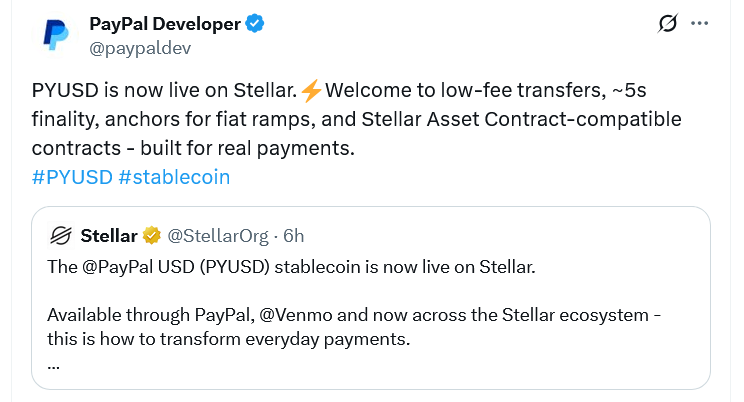PayPal PYUSD0 is a permissionless, fully fungible version of PayPal USD that expands PYUSD across eight new blockchains via LayerZero and Stargate Hydra, enabling mint/burn interoperability and seamless cross-chain transfers for self-custodied PYUSD holders.
-
PYUSD0 brings permissionless, cross-chain PYUSD availability for Tron, Avalanche, Aptos, Abstract, Ink, Sei, Stable, and upgrades on Berachain and Flow.
-
LayerZero handles minting, burning, and deployment while Stargate Hydra serves as the cross‑chain transfer interface.
-
Market context: PYUSD sits around $1.3B market cap vs. USDT $171.2B and USDC $74.3B; Treasury projects stablecoins could reach $2T by 2028.
PayPal PYUSD0: PayPal expands PYUSD permissionless across eight blockchains via LayerZero’s Stargate Hydra bridge — learn how PYUSD0 enables seamless cross-chain transfers.
Published: 2025-09-18 · Updated: 2025-09-18 · Author: COINOTAG
What is PayPal PYUSD0?
PayPal PYUSD0 is a permissionless, fully fungible variant of PayPal USD (PYUSD) deployed across multiple blockchains. It enables minting and burning on each chain and uses Stargate Hydra for transfers, allowing self-custody holders to move PYUSD seamlessly between supported networks.
How does PayPal expand PYUSD across blockchains?
PayPal expanded PYUSD to eight additional chains using an integration with LayerZero and Stargate Hydra. LayerZero supports mint/burn and cross-chain messaging; Stargate Hydra handles transfer settlement. The supported chains include Tron, Avalanche, Aptos, Abstract, Ink, Sei, and Stable. Existing permissionless versions on Berachain and Flow upgrade to the unified PYUSD0 standard. Separately, PYUSD was also added to Stellar.
PayPal initially launched PYUSD in August 2023, issued by Paxos, and has since broadened native chain support to include Ethereum, Solana, Arbitrum, Stellar, and now the networks above.
Payments giant PayPal is expanding PayPal USD through a permissionless standard called PYUSD0. The move is aimed at increasing on‑chain accessibility and interoperability for holders who self-custody stablecoins.
LayerZero Labs will enable cross‑chain minting and burning mechanics for PYUSD0, while Stargate Hydra will act as the transfer layer. The integration seeks to reduce reliance on centralized rails when moving PYUSD across chains.
LayerZero posted a statement describing PYUSD0 as “fully fungible” with existing PYUSD deployments and noted the upgrade path for prior permissionless versions on Berachain and Flow.
LayerZero core commentary (LayerZero_Core) — September 18, 2025: “The result of this integration is better money experiences utilizing modern technology. Anyone who self-custodies their PYUSD can move it seamlessly between blockchains without needing to rely on the existing and centralized banking infrastructure.”
Why does this matter for stablecoin adoption?
Expanding PYUSD permissionlessly across multiple chains increases liquidity distribution and user access in markets where on‑chain rails are essential. Stablecoins are central to crypto payments, trading, and cross-border value transfer; broader native support reduces friction and costs for users transferring value between chains.
How big is the market opportunity?
US Treasury estimates from April projected the stablecoin market could grow from roughly $295 billion to $2 trillion by 2028. Major incumbents Tether (USDT) and Circle (USDC) remain largest by market cap (CoinGecko data), but PayPal’s PYUSD — at about $1.3 billion market cap — aims to scale via cross-chain availability.

Stellar integration was announced separately, highlighting adoption on low-fee networks with fast finality. PayPal’s PYUSD issuance by Paxos remains the regulatory and operational backstop for the asset.
Frequently Asked Questions
Which blockchains did PayPal add PYUSD0 to?
PayPal added PYUSD0 to Tron, Avalanche, Aptos, Abstract, Ink, Sei, and Stable; Berachain and Flow permissionless versions will upgrade to PYUSD0. Stellar received a separate PYUSD integration.
How will transfers work for self-custody holders?
Self-custody holders can move PYUSD0 across supported chains using Stargate Hydra as the transfer layer; LayerZero facilitates cross-chain minting and burning to preserve fungibility and supply integrity.
Key Takeaways
- Permissionless expansion: PYUSD0 enables PayPal USD to be minted, burned, and moved across eight additional blockchains.
- Infrastructure partners: LayerZero manages mint/burn and messaging; Stargate Hydra handles transfers.
- Practical impact: Broader native chain support improves access and reduces reliance on centralized rails for cross-chain stablecoin movement.
Conclusion
PayPal’s launch of PYUSD0 marks a significant step in making PYUSD more interoperable and accessible across multiple blockchains. By combining LayerZero’s mint/burn primitives with Stargate Hydra transfers, PYUSD0 aims to streamline cross-chain stablecoin flows for users who self-custody assets. Expect continued network additions and protocol upgrades as stablecoin infrastructure evolves.





